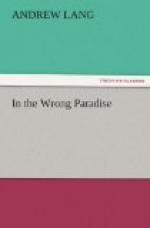* * * * *
Dawn was growing into day before we reached the mouth of the cave again, and after a series of journeys brought all our spoil to the light of the upper air. It was quickly enough bestowed in bags and baskets. Then, aided by three of Moore’s stoutest hands, whom we found waiting for us in the pine wood, we carried the whole treasure back, and lodged it in the strong room which had been the retreat of Gumbo.
III.
The conclusion of my story shall be very short. What was the connection between Gumbo and the spoils of the Sachem’s Mound, and how did the treasures of the Aztec Temple of the Sun come to be concealed in the burial place of the Red Man? All this Moore explained to me the day after we secured the treasures.
“My father,” said Moore, “was, as you know, a great antiquarian, and a great collector of Mexican and native relics. He had given almost as much time as Brasseur de Bourbourg to Mexican hieroglyphics, and naturally had made nothing out of them. His chief desire was to discover the Secret of the Pyramid—not the pyramids of Egypt, as you fancied, but the Pyramid of the Sun, Tonatiuh, at Teohuacan. To the problem connected with this mysterious structure, infinitely older than the empire of Montezuma, which Cortes destroyed, he fancied he had a clue in this scroll.”
Moore handed me a prepared sheet of birch bark, like those which the red men use for their rude picture writings. It was very old, but the painted characters were still brilliant, and even a tyro could see that they were not Indian, but of the ancient Mexican description. In the upper left-hand corner was painted a pyramidal structure, above which the sun beamed. Eight men, over whose heads the moon was drawn, were issuing from the pyramid; the two foremost bore in their hands effigies of the sun and moon; each of the others seemed to carry smaller objects with a certain religious awe. Then came a singular chart, which one might conjecture represented the wanderings of these men, bearing the sacred things of their gods. In the lowest corner of the scroll they were being received by human beings dressed unlike themselves, with head coverings of feathers and carrying bows in their hands.
“This scroll,” Moore went on, “my father bought from one of the last of the red men who lingered on here, a prey to debt and whisky. My father always associated the drawings with the treasures of Teohuacan, which, according to him, must have been withdrawn from the pyramid, and conveyed secretly to the north, the direction from which the old Toltec pyramid builders originally came. In the north they would find no civilized people like themselves, he said, but only the Indians. Probably, however, the Indians would receive with respect the bearers of mysterious images and rites, and my father concluded that the sacred treasures of the Sun might still be concealed among some wandering




